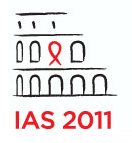Low birth weight and preterm delivery
1 August 2011. Related: Conference reports, Pregnancy, IAS 6th Rome 2011.
 Polly Clayden, HIV i-Base
Polly Clayden, HIV i-Base
Data describing the risk of low birth weight (LBW) and preterm delivery (PTD) associated with maternal HIV and antiretroviral exposure are conflicting and international consensus has not been reached. Two posters from the Antiretroviral Pregnancy Registry (APR) and the Perinatal HIV Research Unit (PHRU), Soweto, South Africa, presented at IAS 2011, showed findings from their analyses of LBW and PTD in their respective cohorts. [1, 2]
APR is a prospective exposure-driven birth registry to monitor for potential increased birth defects following ART exposure in pregnancy.
In this study, Karen Beckerman and colleagues analysed reports to the APR cohort from 1989-2010. They restricted outcomes to singleton live births without birth defects. After establishing overall LBW(<2500 g)/PTD(< 37 weeks) prevalence by type of ART (2 or more drug regimens with and without PI), the data were stratified for maternal age, race/ethnicity and CD4 count. Stratified analysis is based on the 2×2 chi-square test and Cochrane-Mantle-Haenzel.
The investigators found, among the 10082 live births with birth weight data available, 16% were < 2500 g. Of those with reported estimated gestational age, 12.8% were <37 weeks. There were significantly higher LBW/PTD women receiving PI-containing regimens vs regimens without PI (LBW RR=1.22, p<0.001; PTD RR=1.27, p<0.001). But after controlling for maternal age, race/ethnicity and CD4 count they found no significant increase in incidence of LBW/PTD associated with PI exposure among groups with lower pre-existing risk. See Table 1: Low birth weight, preterm delivery and PI exposure in APR.
| % of cohort (n/total) | Low birth weight | RR, PI vs no PI | Preterm delivery | RR, PI vs no PI | |||
|---|---|---|---|---|---|---|---|
| Low risk maternal characteristic | Live births with known BW or GA | % PI | % No PI | % PI | % No PI | ||
| Age 20-34 | 77% (7340 BW, 7737 GA) | 15.4 | 14.2 | 1.09 (0.22) | 12.7 | 10.5 | 1.21 (0.01) |
| Ethnicity White/ Latina | 33% (3169 BW, 3360 GA) | 13.2 | 12.7 | 1.04 (0.73) | 11.6 | 11.5 | 1.00 (0.98 |
| CD4 count >500 cells/mm3 | 32% (3065 BW, 3237 GA) | 16.1 | 14.0 | 1.15 (0.15) | 12.9 | 11.8 | 1.10 (0.37) |
The investigators concluded that among prospective reports to APR, increases in LBW/PTD were not associated with PI exposure in women with low background risk for these complications.
In a related study, Fatima Laher and colleagues from PHRU investigated risk factors for PTD in their cohort. They noted that prevalence for PTD is 17.5 in Southern Africa.
This study was a retrospective review of all HIV-positive pregnant women who received triple-combination ART between August 2004 and September 2010. Obstetric history, ART history, maternal CD4 count and viral load during pregnancy were recorded for all live births. Univariate analysis included variables associated with preterm delivery.
The investigators found, out of a total 223 pregnancies, 58 were electively terminated (26%), 19 were spontaneous miscarriages (8%), 16 did not yet have recorded outcomes (7%), and 4 were stillbirths (2%). There were 126 (57%) live births, and 62/126 (49%) were PTDs with median gestational age 34.7 weeks (IQR 33.0-35.7). Mothers of preterm and term infants were similar in age, median 31.7 and 30.9 years respectively. Virological suppression <50 copies/mL during pregnancy was similar in both groups, 84% and 80% respectively.
The majority of women, 111/126 (88%) initiated ART was before conception. Maternal CD4 count during pregnancy below 200 cells/mm3 [OR 1.2; 95%CI 0.5-2.8, p= 0.76], 350 cells/mm3 [OR 1.4; 95%CI 0.7-2.8, p= 0.37], or 500 cells/mm3 [OR 1.1; 95%CI 0.4-2.8, p=0.87], were not risk factors for PTD.
Final-trimester maternal use of EFV-based regimens [OR 2.5; 95%CI 0.9-6.9, p=0.09], or PI-based regimens [OR 1.4; 95%CI 0.6-3.0, p=0.4], were not predictive of PTD compared to NVP-based regimens.
The investigators concluded that preterm delivery is common among pregnant ART-recipients in Soweto. Maternal CD4 count and final-trimester ART type seem not to predict preterm delivery. They noted that their small sample size in this study is a limitation.
comment
The APR data are unsurprising as 85% of the pregnancies enrolled are from the US and the association with PTD and PIs is largely not observed in American cohorts. The Soweto data may reflect a high background PTD rate and, as the investigators note, a small sample size.
Recently published data from Botswana does show an increased risk of PTD in women reciving PIs in pregnancy. [3]
References
- Beckerman K et al. Exposure to combination antiretroviral (cARV) regimens containing protease inhibitors (PI) during pregnancy and prevalence of low birth weight/preterm delivery (LBW/PTD) among women with low pre-existing risk for LBW/PTD: a stratified analysis of 10,082 p. 6th IAS Conference on HIV pathogenesis, treatment and prevention. 17-20 July 2011. Rome, Italy. Poster abstract TULBPE018.
- Laher F et al. Maternal CD4 and HAART type are not risk factors for preterm delivery amongst HIV-infected pregnant women receiving HAART in Soweto, South Africa. 6th IAS Conference on HIV pathogenesis, treatment and prevention. 17-20 July 2011. Rome, Italy. Poster abstract TUPE319.
- Powis KM et al. Increased risk of preterm delivery Among HIV-infected women randomised to protease versus nucleoside reverse transcriptase inhibitor-based HAART during pregnancy. Journal of Infectious Diseases. Volume204, Issue4. Pp. 506-514.

